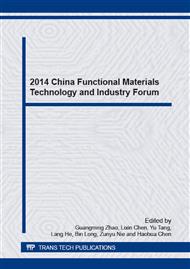[1]
M. Valant, G. S. Babu, M. Vrcon, T. Kolodiazhnyi, and A. K. Axelsson, Pyrochlore Range from Bi2O3-Fe2O3-TeO3 System for LTCC and Photocatalysis and the Crystal Structure of New Bi3(Fe0. 56Te0. 44)3O11, J. Am. Ceram. Soc., 1–7 (2011).
DOI: 10.1111/j.1551-2916.2011.04801.x
Google Scholar
[2]
D. P. Cann, C. A. Randall, and T. R. Shrout, Investigation of the Dielectric Properties of Bismuth Pyrochlores, Solid State Commun., 100.
DOI: 10.1016/0038-1098(96)00012-9
Google Scholar
[7]
529–34 (1996).
Google Scholar
[3]
J. C. Nino, H. J. Youn, M. T. Lanagan, and C. A. Randall, Bi2O3 Solubility of Bi-Based Pyrochlores and Related Phases, J. Mater. Res., 17.
DOI: 10.1557/jmr.2002.0174
Google Scholar
[5]
1178–82 (2002).
Google Scholar
[4]
J. C. Nino, I. M. Reaney, M. T. Lanagan, C. A. Randall, Transmission electron microscopy investigation of Bi2O3–ZnO–Nb2O5 pyrochlore and related phases, Materials Letters 57 (2002) 414–419.
DOI: 10.1016/s0167-577x(02)00802-9
Google Scholar
[5]
R. A. M. Osman, A. R. West, Electrical characterization and equivalent circuit analysis of (Bi1. 5Zn0. 5)(Nb0. 5Ti1. 5)O7 Pyrochlore, a relaxor ceramic, J. Appl. Phys. 109, 0741061-8 (2011).
Google Scholar
[6]
M. Valant, P. K. Davies, J. Am. Ceram. Soc. 83 (2000) 147.
Google Scholar
[7]
M. Valant, P. K. Davies, J. Mater. Sci. 34 (1999) 5437.
Google Scholar
[8]
H Du, X Yao, Xianfeng Zhang, Huimin Weng, Defect structure and dielectric properties of Bi-based pyrochlores probed by positron annihilation, Applied Surface Science 253 (2006) 1856–1860.
DOI: 10.1016/j.apsusc.2006.03.026
Google Scholar
[9]
H Du, X Yao, Dielectric relaxation characteristics of bismuth zinc niobate pyrochlores containing titanium, Physica B 324 (2002) 121–126.
DOI: 10.1016/s0921-4526(02)01284-x
Google Scholar
[10]
Huiling Du, Xiang Shi, Yu Cui, Defect structure and electrical conduction behavior of Bi-based pyrochlores, Solid State Communications, 2010(150) 1213~1216.
DOI: 10.1016/j.ssc.2010.04.008
Google Scholar
[11]
Chi Chen, Weixing Cheng, Huiling Du, Research on the dielectric properties and fine structure of BZN-based pyrochlore ceramics, Electronic Components and Materials, 2007 2 49-51.
Google Scholar
[12]
I. Levin, T.G. Amos, J.C. Nino, T.A. Vanderah, C.A. Randall, M.T. Lanaganand, Structural study of an unusual cubic pyrochlore Bi1. 5Zn0. 92Nb1. 5O6. 92, J. Solid State Chem. 168 (2002) 69–75.
DOI: 10.1006/jssc.2002.9681
Google Scholar
[13]
N. E. Brese, M. O. Keeffe, bond-valence parameters for solids[J], Acta Cryst, 1991(B47): 192~197.
Google Scholar
[14]
B. Melot, E. Rodriguez, Th. Proffen, et al. Displacive disorder in three high high-k bismuth oxide pyrochlores. Materials Research Bulletin, 2006, 41(5): 961~966.
DOI: 10.1016/j.materresbull.2006.02.004
Google Scholar
[15]
R. Kudesia, A. E. Mchale, R. L. Snyder, J. Am. Ceram. Soc. 77(1994)3215.
Google Scholar
[16]
R. Christoffersen, P. K. Devis, X. Wei, ibid, 77(1994)1441.
Google Scholar
[17]
H Du, X Yao, J. Materials Science, 15(2004)613-616.
Google Scholar
[18]
Huiling Du, Xiang Shi, Yu Cui, Defect structure and electrical conduction behavior of Bi-based pyrochlores, Solid State Communications 150 (2010) 1213–1216.
DOI: 10.1016/j.ssc.2010.04.008
Google Scholar
[19]
K. Prasad, K. Kumari, K. P. Chandra, K. L. Yadav, S. Sen, Dielectric relaxation and ac conductivity of WO3 added (Na1/2Bi1/2)TiO3 ceramic, Materials Science-Poland, Vol. 27, No. 2, 2009 373-384.
DOI: 10.1590/s0103-97332009000300010
Google Scholar
[20]
B.P. Dasa, R.N.P. Choudhary, P.K. Mahapatra, Mater. Sci. Eng. B 104 (2003) 96.
Google Scholar
[21]
W. Li, K. Chen, Y.Y. Yao, J.S. Zhu, Y.N. Wang, Appl. Phys. Lett. 85 (2004) 4717.
Google Scholar
[22]
Z.Y. Wang, T.G. Chen, Phys. Stat. Sol. 3 (1998) 167.
Google Scholar
[23]
Bauerle J E, Hrizo J, J. Phys. Chem. Solids, 1969 30 565-570.
Google Scholar
[24]
Abelard P, Baumard J F, Phys Rev., 1982, B26, 1005-1017.
Google Scholar
[25]
Badwal S P S, J. Mater. Sci., 1984, 19 1767-1776.
Google Scholar
[26]
Solier J D, Perez-Jubindo M A, Dominguez-Rodriguez A, et al. J. Am. Ceram. Soc., 1989 72 1500-1502.
Google Scholar
[27]
Badwal S P S, J. Am. Ceram. Soc., 1990 73 3718-3719.
Google Scholar


